From IPOs to crypto, and more: Answering 10 FAQs for 2022
Forbes India looks for answers to burning issues of the New Year, including the India-China conflict, telecom tariffs, Indian IPOs, and more
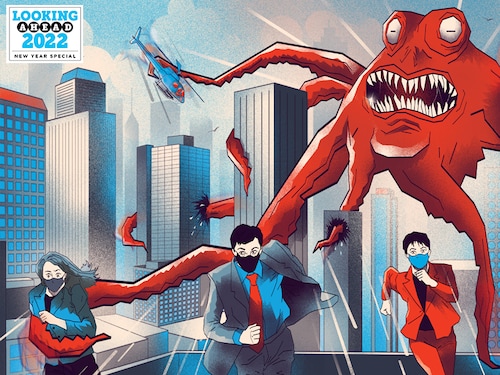

 Analysts say the economy is poised to grow provided the Omicron variant does not lead to material loss of economic activity
Analysts say the economy is poised to grow provided the Omicron variant does not lead to material loss of economic activity
Illustrations: Chaitanya Dinesh Surpur
Since the coronavirus outbreak, the world has been grappling with its variants. The World Health Organization describes Omicron as a variant of concern. It has several mutations that may have an impact on how the virus behaves. The UK on December 22 reported over a lakh cases in 24 hours, while the numbers are increasing across Europe and South Africa too. India has reported over 578 cases of the new variant as of December 27, resulting in plans of reopening offices being put on the back burner. Analysts say the economy is poised to grow provided the Omicron variant does not lead to material loss of economic activity. The virus can potentially reduce travel and hospitality spending, which was expected to boost local businesses during the holiday season. Global capital markets fell by nearly 10 percent because of growing Covid-19 cases in developed markets, concerns over Omicron, withdrawal of incentives from the US and expectations of accelerating rising interest rates. In fact, the UK on December 22 reported that its growth slowed more sharply than expected and Omicron is making matters worse. In India, the second Covid-19 wave led to a contraction in gross value added by 6.2 percent in FY21, with six out of eight key sectors witnessing a decline. While the economy recovered between July and December, Omicron can prove to be a dampener for the recovery trajectory.
- Pooja Sarkar
The answer is simply, yes. Customers need to accept that the days of low-cost voice and data plans are over.
India has, for several years, attracted the lowest average revenue per user (ARPU) in the world at $1.45 as companies attracted and retained subscribers by offering lower rates.
Telecom operator Bharti Airtel and Vodafone Idea (VI) raised tariffs twice in 2021, which probably prompted Jio to hike rates once for its prepaid entry-level packs. Airtel, which has the highest ARPU (see chart), can take the risk of losing some subscribers—who may shift to cheaper data packs—as it has managed to fortify its postpaid and high-end base with loyal customers. For Reliance’s Jio Platforms, the market leader, the ability to raise prices depends on its aspiration for market share dominance. But VI has had little option but to raise prices to boost its ARPUs, which were in the range of around Rs 200 in 2015-16, from the average Rs 150 now.
The telecom landscape will become more competitive in fiscal FY23 with the start of 5G spectrum auctions in mid-2022, according to media reports quoting Ashwini Vaishnaw, union minister for communications, electronics and information technology, and railways. The regulator Telecom Regulatory Authority of India (Trai) is expected to submit its pricing report in March 2022.
Jio Platforms and Bharti Airtel are planning on allocation of capital toward 5G, and VI needs to intensify its need for fundraising while planning for the future. These three leading telecom companies have realised that tariff hikes will be imperative for their sustainability and, most importantly, they have seen that the customer response has not been negative.
- Salil Panchal
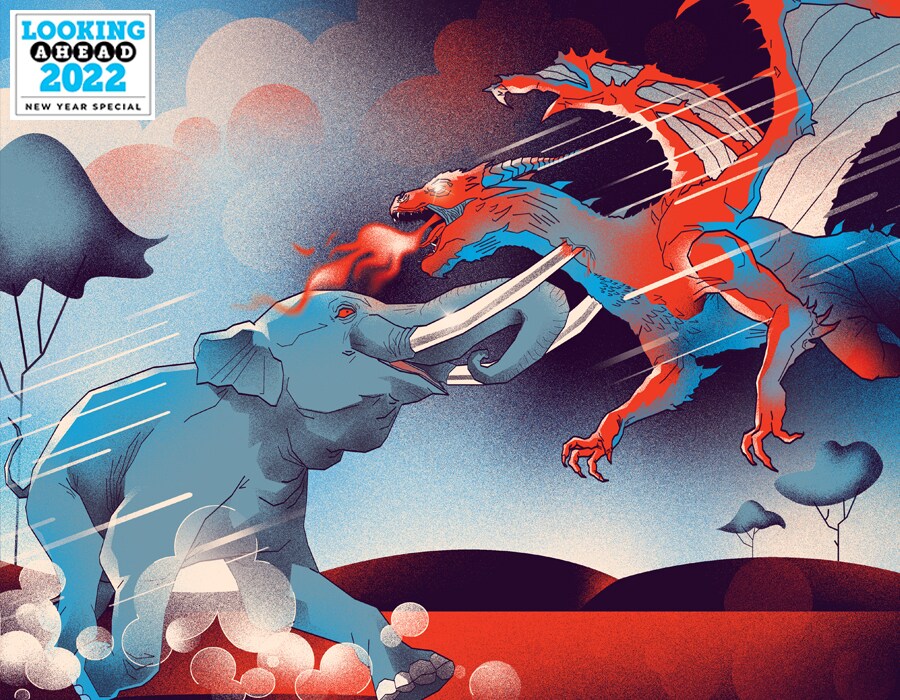
Expect 2022 to see troops deployed on both sides of the India-China border with the occasional news that infrastructure on the border continues to be strengthened. Xi Jinping, president of China, is expected to further strengthen his position and possibly appoint himself to a third term in 2022. During the interim, the party has to whip up nationalist sentiments and there is no better way than keeping the India border hot. “They want to pick on someone their size and internally (in China), India is considered a US ally. Picking on Taiwan or creating trouble in the South China Sea does not have the same effect," says Jabin Jacob, associate professor at the department of international relations at Shiv Nadar University. He also points to the fact that other adversaries have not fought back. There is also slowing economic growth due to a planned deflation of real estate prices. Already reports from China indicate that several projects of real estate company Evergrande have been stalled, dragging down prices as well as demand for commodities. A border dispute is the perfect foil to distract public opinion from slowing growth. Expect renewed activity once the Himalayan snow melts as both sides strengthen roads, communication and troop rotations at the border. A hot war with India is unlikely as the Taiwan issue is seen as more pressing for now.
- Samar Srivastava
There may not be a simple response to this question, considering that 2022 is likely to be the year when India will get greater regulatory clarity on cryptocurrencies. The stand that the government and regulatory agencies take will determine whether cryptocurrencies will remain hot or not.
The year 2021 has ended with just speculation surrounding the discussion of a revised Cryptocurrency and Regulation of Official Digital Currency Bill. The Bill was expected to be introduced in Parliament for discussion in the Winter Session, which ended on December 23. The government might take the ordinance route to fast-track the legislation process for cryptos or it might choose to wait until the next session of Parliament. But we can be sure about one thing: 2022 will be the defining year for cryptocurrencies after about two years of mainstream adoption of these into the trading and investing ecosystem.
Two of India’s largest cryptocurrency exchanges, CoinDCX and CoinSwitch Kuber, became unicorns in 2021, testimony to the fact that millions of young Indians are trading in cryptocurrencies. The Reserve Bank of India is unsure about the actual number of Indians trading in crypto, which is speculated to be at 10 crore, higher than in the US and Russia. Experts, informally, suggest the number could be closer to two crore. Corporates have already begun integrating crypto services or products as part of their key offerings and investors have already begun adopting crypto as part of their portfolios. This trend is likely to continue unabated.
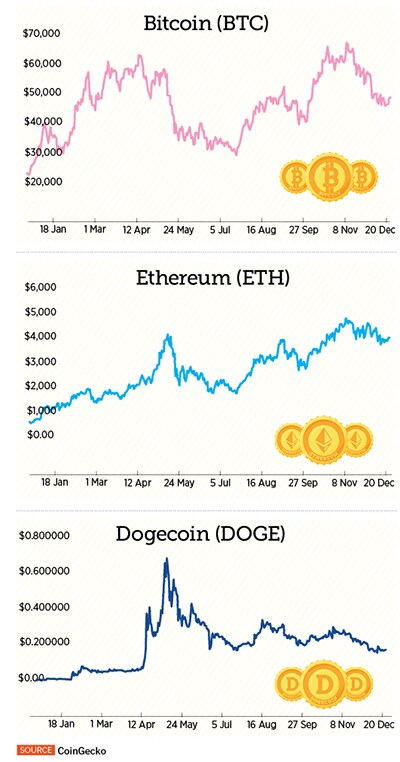
Most of the widely-traded cryptocurrencies such as Bitcoin, Ethereum, Dogecoin and Shiba Inu were volatile through 2021 (see chart) but it did not make them less attractive. Bitcoin climbed to record levels on reports of possible adoption by global investment banks, but the news of China’s blanket ban led to a crash, followed by a recovery after the US SEC allowed for futures-backed Bitcoin ETFs in October. Bitcoin fell again in November.
Ethereum started 2021 with a bang, driven by the multiple use cases that it can support, from NFTs to Metaverse. But it is heavily correlated to Bitcoin price trends and corrected from there in the year, only to end 2021 slightly firm at $3,900 levels. Dogecoin really became mainstream in India and elsewhere in 2021 and is expected to continue to gain in popularity. Shiba Inu in 2021 covered much ground and for some experts has started to be considered as a recognised cryptocurrency. 2022 will determine that.
The rise of non-fungible tokens (NFTs) was another major theme in 2021, driven by artists, sports personalities and celebrities across the globe, who digitalised and tokenised their art. Now experts are looking towards crypto gaming and decentralised finance (whereby financial products are available on a public decentralised block chain network) as engines for growth in the crypto ecosystem. 2022 holds a lot of promise but the watchwords may be crypto scammers.
- Salil Panchal
They will be in demand in 2022, but unlike 2021, where over 75 percent of the companies got a positive listing, in the New Year, pricing and timing will determine success. Also, attention from investors is likely to get skewed toward just a few issues, particularly the mega-offering from LIC and a large offering from the NSE at an undisclosed date later in 2022. Overall, there are 36 companies proposing to raise roughly over Rs 50,000 crore and have regulatory approval. Another 31 companies looking to raise about Rs 57,000 crore are awaiting Sebi’s approval.
The year 2021 saw a record in excess of Rs 1 lakh crore being raised by companies through the primary markets, which was almost double that of the previous highest of Rs 58,075 crore in 2017. There are enough companies waiting to go public and raise capital, with existing promoters, PEs and VCs in these companies looking to exit. So, the supply side is strong. But the demand side will depend on the liquidity situation.
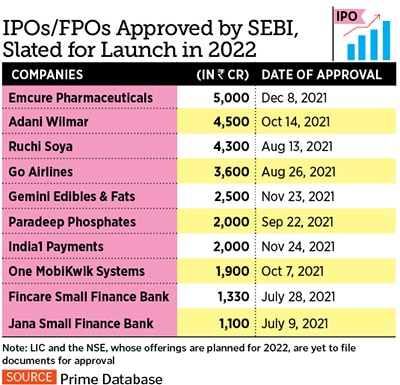
Interest rates are likely to rise in 2022, which will suck out liquidity across various markets. For the primary market to be robust, we will need a bullish secondary market. If the secondary market goes into a bearish mode, the number of companies seeking to raise fresh capital will slow down. Besides lower liquidity, the impact of the Omicron variant of Covid-19 on business activity, mobility and consumption will have to be seen. Foreign investors will participate in new offerings based on their liquidity position while domestic retail investors are likely to buy into new offerings either directly or through mutual fund schemes. Capital from retirees will continue to move to other asset classes such as equities due to unattractive fixed deposit rates.
- Salil Panchal
The year 2021 was a relatively good year for investors, and the strong flow of initial public offerings (IPO) added to the euphoria. Until November, the bulls on Dalal Street seemed invincible, given the historic surge in the benchmark indices. The S&P BSE Sensex has returned close to 20 percent to investors in the volatile calendar year. Consider this: The index was perched at 47,785 points on the first day of trading in 2021. In the following months, it touched a low of 46,160 points, but brushed it off, and quickly recouped to touch a high of 62,245 points in a matter of weeks. Yes, it was quite a dizzy ride for Indian equities.
This, despite the fact that Foreign Institutional Investors (FII)—seen as the main drivers of Indian equities—have been net sellers of stocks to the tune of `47,000 crore. This is the second biggest share sale by FIIs seen in India. Reason? Indian equity valuations are seen as expensive. The MSCI India Index is currently trading at a premium of over 79 percent to the MSCI Emerging Markets Index. The prospect of the US Federal Reserve hiking rates sooner than anticipated has also contributed to a shift in portfolio allocations. Yet, the domestic stock markets stood largely unscathed, given the strong participation of retail investors. Since the pandemic, the number of demat accounts has increased to nearly 80 million from 21 million in February 2020. The entry of retail investors in such large numbers is mainly due to the lack of alternative investment options coupled with the performance of stocks in recent months. Given the recent correction in stock prices, many market watchers do not expect such robust retail participation to continue in the coming months.
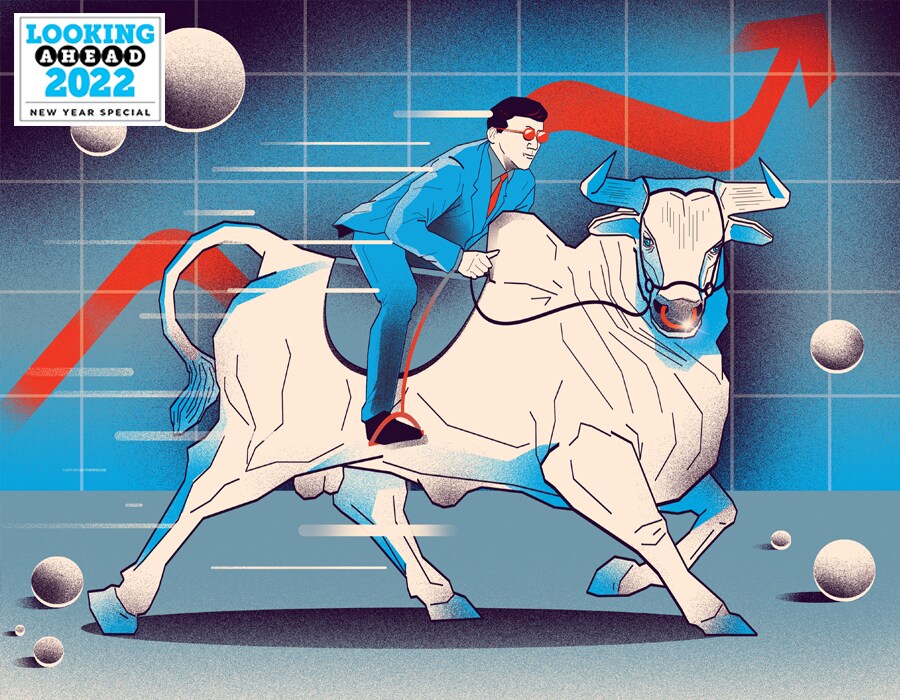 Given the recent correction in stock prices, many market watchers do not expect such robust retail participation to continue in the coming months
Given the recent correction in stock prices, many market watchers do not expect such robust retail participation to continue in the coming months
However, despite the associated risks from the possible strengthening of the US dollar, and the uncertainty around the coronavirus situation, the overall outlook for Indian equities remains bright in 2022. Goldman Sachs expects India’s equity market capitalisation to cross $5 trillion by 2024 to become the world’s fifth largest market. Experts do not rule out a correction from previous top levels, but the long-term growth story remains intact for investors, unless there is a major geopolitical surprise.
- Neha Bothra
The impact of inflationary pressures on the economy has been a key concern over the past two quarters, and Shaktikanta Das, Reserve Bank of India (RBI) governor, has highlighted this risk. “Persistence of high core inflation since June 2020 is an area of policy concern. Input cost pressures could rapidly be transmitted to retail inflation as demand strengthens," he said. In fact, in May and June, CPI inflation (or retail inflation) breached the Monetary Policy Committee’s (MPC) threshold limit of six percent. Since September, retail inflation has hovered around the MPC’s comfort level of four percent. The central bank expects CPI inflation to peak at 5.7 percent in the fourth quarter of the current fiscal.
Economists point out that there are several moving parts weighing on inflation—from supply side factors to the anticipated hike in fiscal spending around State elections—and the ‘RBI’s macro view of the economy downplays the inherent upside risks on inflation’.
In November, wholesale inflation stood at 14.2 percent, up from 12.5 percent in the previous month. The widening gap between retail and wholesale inflation does not augur well for small business owners as it can squeeze margins, hurt profitability, and derail the growth momentum. Economists see an urgent need to augment supply of raw materials like coal for some degree of interim relief. Das has called for a reduction of excise duty and VAT on petrol and diesel to cool inflation.
Most market experts say the RBI is likely to shift its stance to neutral from accommodative in April, and possibly begin the rate hike cycle from June 2022. Few brokerages expect a total rate hike of 100 basis points in the next calendar year. In this scenario, the MPC has the warfare to cool inflation and meet its main objective of ensuring that CPI inflation does not cross the six percent mark. Uncertainty around the Omicron variant of coronavirus persists, and domestic growth is fragile. Yet, developments in the global economy will have a bearing on rate action in the coming months. So, the inflationary situation remains dynamic but, at this point, it seems unlikely that CPI inflation will consistently exceed six percent in 2022.
- Neha Bothra
The year 2021 was all about renewed gumption toward recovery. The festive season witnessed a strong surge in terms of growth and sales owing to pent-up demand and revenge buying, but is it enough to bring the economy back on track? As governments the world over focus on containing inflation over driving growth, India, too, is expected to follow the same playbook. The US Federal Reserve tightened its monetary policy two months before it was expected. The Reserve Bank of India, on the other hand, has maintained a GDP forecast for the current financial year at 9.5 percent.
Last year, the country made a V-shaped recovery, as indicated by the provisional GDP numbers. In the last week of November, global bank Goldman Sachs in its Macro Outlook Report for 2022 raised its projections for India’s GDP to 9.1 percent compared to an earlier estimate of 8 percent, on the expectation of continual government capital expenditure, nascent signs of private corporate capex and a revival in housing sentiment. India’s economy, which contracted during 2020, is expected to grow by 8.5 percent in 2022, according to the International Monetary Fund.
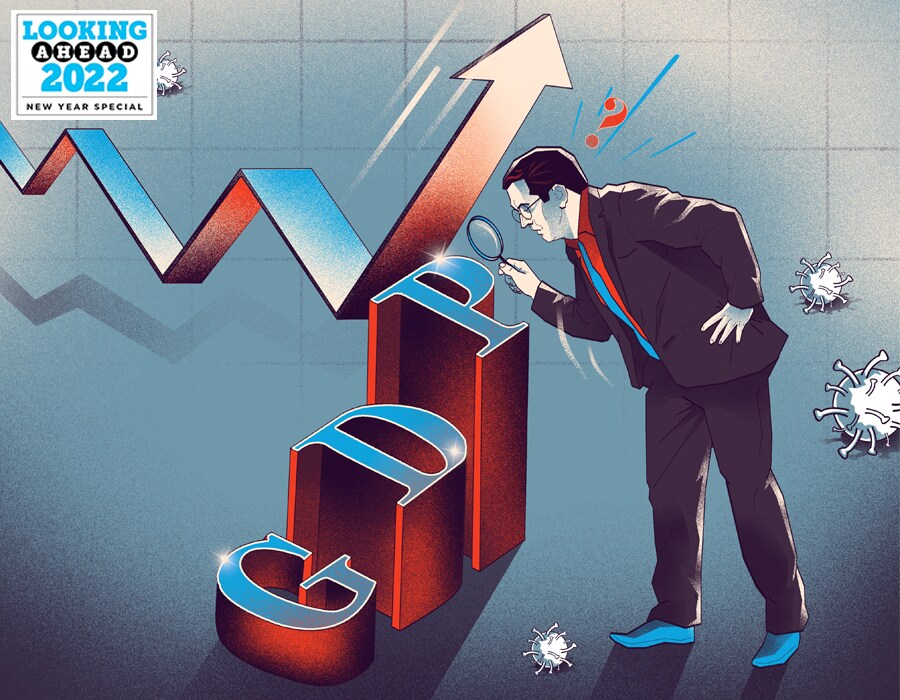 While inflationary curbs will be the biggest overhang, improved listed space profitability and higher cash reserves will help the private sector to deploy capex
While inflationary curbs will be the biggest overhang, improved listed space profitability and higher cash reserves will help the private sector to deploy capex
While inflationary curbs will be the biggest overhang, improved listed space profitability and higher cash reserves will help the private sector to deploy capex. Profitability has also aided government’s tax collections and it is expected to continue this year. The tax collection for April-October at `10.5 trillion was double of last year and beat the pre-Covid figure of Rs 6.8 trillion.
Private entrepreneurs too raised record high capital during the year. Private equity and venture capital investments during the calendar year stood at $72.6 billion, surpassing the all-time high recorded in 2020 by 53 percent, driven by mega investments in startups and large buyouts. Private investors have exited $42.3 billion, 57 percent higher compared to the previous high of $27 billion recorded in 2018, boosting investor confidence in terms of the ability to return capital from Indian investments.
With all parameters working in tandem, unless the Omicron Covid-19 variant creates havoc, the country is poised to positively surprise its peers in Asia.
- Pooja Sarkar
The near-zero interest rates that the US and Eurozone have seen were expected to be a thing of the past in 2022. As a monetary stimulus did, its job inflation had emerged as a more pressing concern.
Inflation is still there, but in the last month of 2021, a new variant of the virus put a spanner in the works. The interest rate cycle is now dependent on level of economic activity and which economy one talks about.
“If economic activity remains buoyant, expect rates to kick upwards," says Ambareesh Baliga, an independent market expert. He points to the fact that the liquidity sloshing around the world has elevated asset prices and policymakers will have to address this at some point.
Already there are signs that central banks would have to raise rates irrespective of how the virus plays out. The Bank of England announced an interest rate hike from 0.1 to 0.25 percent on December 16 on concerns that inflation would exceed six percent in 2022. The Reserve Bank of New Zealand expects rates to rise to two percent by 2022 from the present 0.75 percent.
The elephant in the room is the US Federal Reserve, which has pointed to three rate hikes in 2022. For now, at 1.49 percent, the US 10-year bond yield is not reacting as aggressively as it should to a rate tightening cycle but it remains to be seen how the tightening trajectory moves. “If activity slows (on account of the virus), they might have to price in the status quo," says Baliga.
Expect the trade-off between inflation and growth to get more accentuated. In the end the US Fed will probably have to tighten quickly if inflation continues to remain elevated, sending interest rates rapidly upward.
- Samar Srivastava
A crowded first-half election calendar in 2022—with State assembly elections set for Goa, Manipur, Punjab, Uttar Pradesh, Uttarakhand and then Himachal Pradesh and Gujarat toward the year-end—means that the government will have to deal with more on its hands. The fears of some form of derailment in business activity, mobility and consumption cannot be ruled out as more Omicron variant–led Covid-19 cases rise.
Statistically, the economy appears to be in recovery mode from a dismal 2020, but that is only half the truth. India Today’s Mood of the Nation survey in 2021 revealed that 86 percent of those surveyed had seen a loss of livelihood or shrinkage in income. It also spelt bad news for the popularity of Prime Minister (PM) Narendra Modi whose rating as the most popular PM fell to 24 percent in August from 66 percent a year earlier.
The election rhetoric started in November in a hectic manner in Uttar Pradesh. The focus has been on the infrastructure advancements in the State, including expressways, airports and hospitals. The outcome for all these States will be significant steps for the Bharatiya Janata Party (BJP) and the PM to make another successful bid in the 2024 national elections. The government cannot hope to play the Hindutva or the Ram Mandir card for too long to woo the electorate. Inflation and job losses have become a real concern with the spread of the pandemic. Jobs data in India shows that the LPR (labour participation rate) has slipped from 40.41 percent in October to 40.15 percent in November, according to the Centre for Monitoring Indian Economy (CMIE).
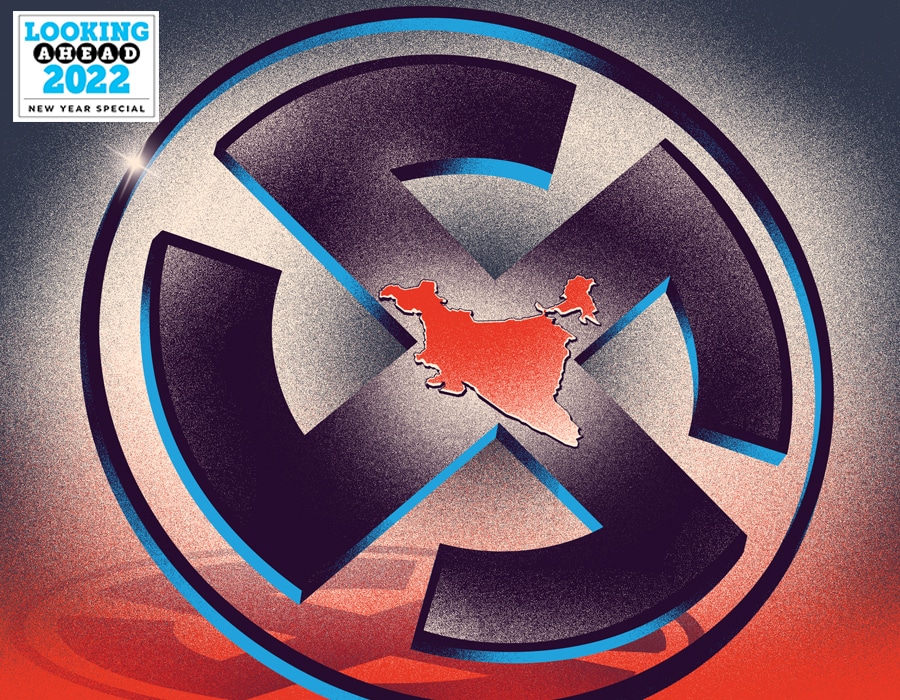 The fears of some form of derailment in business activity, mobility and consumption cannot be ruled out as more Omicron variant–led Covid-19 cases rise
The fears of some form of derailment in business activity, mobility and consumption cannot be ruled out as more Omicron variant–led Covid-19 cases rise
Inflation is starting to worry decision makers at the Reserve Bank of India (RBI). Governor Shaktikanta Das has said headline inflation will peak in the three months to March 2022. The RBI has retained the inflation target for FY22 at 5.3 percent, but there is a strong possibility that this could be revised upward in future policies depending on the impact of Omicron on business activity and consumption demand. So, 2022 will be a critical for the government to tackle economic concerns. If there are political hiccups, it will derail policy making.
- Salil Panchal
First Published: Jan 03, 2022, 14:03
Subscribe Now